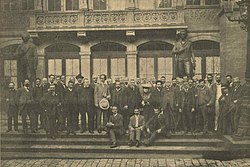Weranian Section of the Workers' International
Weranic Section of the Workers' International Ostisch Sektion der Arbeiter Internationale | |
|---|---|
 | |
| Abbreviation | OSAI |
| First Secretary | Veronika Althammer |
| Deputy Chairperson | tba |
| Parliamentary leader | Peter Lötzsch |
| Founded | 2 February 1901 |
| Preceded by | Weranian Socialist Party Weranian Socialist Workers' Party |
| Headquarters | Westbrucken |
| Youth wing | Weranic Socialist Youth Movement |
| Membership | 500,000 (claimed supporters) |
| Ideology | Impossibilism Communism Socialism Anti-capitalism Republicanism |
| Political position | Left-wing to far-left |
| European affiliation | Mixed Radical Left |
| International affiliation | Congress of the Workers' International |
| Colours | Red |
| Anthem | Die Rote Fahne The Red Flag |
| House of Deputies | 22 / 545
|
| House of Councillors | 5 / 232
|
| Landtage | 88 / 1,151
|
| Euclean Parliament | 6 / 122
|
| Party flag | |
 | |
The Weranic Section of the Workers' International (Weranic: Ostisch Sektion der Arbeiter Internationale) abbreviated and commonly known as the OSAI is a socialist political party in Werania. The oldest political party in Werania form its creation in 1901 to the 1980's it was the dominant left-wing political party in the country and one of the most important parties in the country's political history.
The OSAI was founded as a merger between the more radical Weranian Socialist Party and the more reformist Weranian Socialist Workers' Party during the International in 1901, becoming a unified party of the Weranian socialist party. It emerged as the primary opposition to the conservative-liberal duopoly in that period, competing with the Catholic Social Party following the institution of universal male suffrage. Following the Great Collapse the OSAI agreed to cooperate with the centre-left Radical Party in the 1918 elections, leading to a split-off by the Weranic Syndicalist Union to occur. .
In 1918 the OSAI became the largest party in the Volkstag and led government under the charismatic leadership of Albrecht Küchenthal who formed a government with the Radicals. Küchenthal's assassination in 1918 saw the unity between socialists, social democrats, communists and syndicalists weaken. The April Revolution in Kirenia saw the party split between the majority who supported the revolution and the minority who were more lukewarm in their support. The minority subsequently formed a coalition with the conservatives splitting to create the Social Democratic Party of Werania (SPO). The split permanently divided the socialist movement in Werania between more statist, social-democratic moderates in the SPO and the more syndicalist, socialist radicals in the OSAI. Another split would occur in 1925 with the creation of the Workers' Party of Werania.
The OSAI would maintain its place as the largest political party throughout the 1920's although it was subject to a cordon sanitaire by the political centre and right. During the Great War the majority of the OSAI would support the government (the landsmann union) with the internal pacifist wing opposed to the "bourgeois war". Although the party hoped to play a role in the post-war reconstruction the right continued the cordon sanitaire through the perpetuation of the so-called "National Bloc" governments which increasingly tended towards the far-right.
The OSAI was united in opposition to the colonial wars in Masari during the 1940's and the later Kirenian-Weranian War. The defeat to Kirenia led to the OSAI to alongside the SPO and the KSP agree to the creation of the tripartite governments, an alliance of socialists, social-democratic reformists and Sotirian democrats. Although the OSAI was the largest party in the coalition it was led by a social democrat, Viktor Beer-Hofmann. The tripartite governments would see Werania reorient into a pro-Euclean direction and lay the foundations of the Weranian welfare state. The OSAI however left government in 1955 when the KSP withdrew from the coalition forming a government with other conservatives.
The formation of a unified right-wing party - the National Consolidation Party (NKP) - in 1957 would lead to the OSAI to lose its place as Werania's largest political party, although it would continue to dominate the left-wing through its alliance to the largest trade union federation, the Weranian Federation of Workers (OAV). The OSAI would begin to be eclipsed on the left by the formation of the Social Democratic Radical Party of Werania who would become the opposition in 1980. In 1984 the SRPO and OSAI formed a coalition government under Ludolf Ostermann which implemented radical left-wing policies including nationalisation of industry and a move towards a "socialist society". However in 1987 Ostermann made a radical u-turn towards a more neoliberal, austerity-focused approach due to pressure from the Euclean Community. The OSAI was split between those who supported the Ostermann government and joined the SRPO and those who continued to support left-wing policies - notably the majority of the Ruttish section of the party defected to the SRPO leading to the OSAI to lose most of its support at the 1988 election.
As a result of the loss of support the OSAI began a move to the centre, jettisoning some of its most radical policies and attempting to present a more democratic socialist profile. In 1995 the OSAI entered a coalition with the SRPO and Green Party which governed until the 1999 election when it was defeated by a conservative majority. The OSAI would continue to decline to the status as a minor party during the 2000's, briefly becoming the third largest party following the 2005 financial crisis before again declining after 2011. The OSAI fell to its lowest seat share since its creation in the 2019 federal election.
The OSAI support the creation of a society based on socialism, internationalism and pacifism through the creation of a Weranian Räterepublik. The OSAI continue to be mainly supported by industrial workers', students and intellectuals continuing to be associated with the OAV trade union federation.
History
Context

Weranian socialist politics traces it's origins back to the Easter Revolution when radical members of the republican movement attempted to institute a new republic in the city of Wiesstadt in 1856 following the end of the War of the Triple Alliance. Although the revolution was led by people such as Sebastian Mertz who represented the classical republican movement more radical figures advocated for utopian socialist goals. The most prominent was the literary writer Bastian Fischart who promoted a synthesis between the republican mainstream and the nascent socialist movement, whose theory of mutualism sought to combine republican virtue with a socialist view of class relations. The Easter Revolution's ultimate failure led to the Weranian socialist movement to disperse as the more conservative republicans rejected the increasing Nemtsovite thought of the influential philosopher Yuri Nemtsov.
The suppression of the Easter Revolution meant the Weranian left was bitterly divided. Republicans often saw the socialists with distrust whilst the exile of prominent left-wing politicians meant the left often had no unifying figure to rally behind. Fischart was seen as the most viable candidate being a charismatic orator and respected writer mainly for his play Amort and historical novel Eine Tragödie but his long exile abroad and his own often eclectic political beliefs frustrated efforts to unify the Weranian left.
In the 1870's the Weranian government issued an amnesty on those who had participated in the Easter Revolution allowing them to return from exile to Werania. Fischart attempted to unify the Weranian left behind a single republican movement but his own weak health meant this collapsed in 1874 with his death. Ludwig Vollmar subsequently created the Weranian Socialist Party (Ostischersozialistische Partei; OSP), the first socialist political party in Werania. Vollmar sympathetic to syndicalism being opposed to parliamentary politics, being accused of impossibilism by more moderate socialists. Nevertheless syndicalist influence in the Weranian Federation of Workers' (Ostischer Arbeitsverband; OAV) meant that the OSP had strong influence within Weranian society even gaining seats in the Bundestag.
Tensions grew within the OSP between the leadership gathered around the increasingly ageing Vollmar and possibilists grouped around Joachim Heisenberg. Heisenberg supported a passive strategy regarding the formation of centre-left governments in contrast to Vollmar who supported a more confrontational approach. This disconnect led to in 1880 Heisenberg supporting the liberal government of Ažuolas Kuzmickas - as a result Vollmar and his supporters had Heisenberg expelled from the OSP. Heisenberg subsequently created the Weranian Socialist Workers' Party (Ostischersozialistische Arbeiterpartei; OSAP) which supported a more evolutionary form of socialism.
The OSP and OSAP split combined with continued suffrage restrictions of much of the male working class constrained the development of socialist politics in Werania. Although both parties supporting the creation of a socialist republic that would repudiate both monarchism and capitalism they differed widely on how to achieve such a goal with the OSP generally supporting a revolutionary approach that would lead to them seizing power in a general strike whilst the OSAP was more supportive of a reformist approach actively promoting parliamentary routes to socialism. The OSAP never became more powerful then the OSP in terms of membership or influence due the OSP continuing to gather support from the OAV which became more radical in it's syndicalist goals. Additionally some socialists refused to be associated with either party, tending to be more moderate and sitting in the "Republican Bloc" in the House of Deputies.
In 1883 a general strike was called. Ostensibly the strike was in support of universal suffrage but many within the movement called for the creation of a socialist republic and other more revolutionary aims. The disunity among the left in relation to the strike led to the conservative cabinet of Xaver von Aehrenthal fearful of a second Easter Revolution to crush the strike sending the National Guard to use force to break up workers' and arresting revolutionary agitators. A series of anti-socialist laws were passed whose intent was to cripple the OSP and OSAP - trade unions were banned, meetings of socialist groups restricted and censorship of the press imposed.
The passage of the anti-socialist laws meant that the unification of the OSP and OSAP into a single socialist movement gathered momentum in the 1880's and 1890's. Both parties circumvented the anti-socialist laws by running for the Bundestag as independents and holding many of their meetings across the border in Azmara and Estmere. Both parties additionally became united behind the common cause of ending the anti-socialist laws. In 1891 another general strike calling for the repeal of the anti-socialist laws was held that paralysed Werania for over a week. With the government fearful of the strike escalating into a revolution King Adalbert overruled the objections of conservative premier Adolf Ritter von Kral allowing interior minister Konrad von Höhnel to repeal the anti-socialist laws leading to the re-legalisation of trade unions.
Despite the victory in repealing the anti-socialist laws the Weranian left remained divided, not least due to the insistence of the OSAP to be part of a republican rather then socialist coalition resulting in cooperation remained limited and haphazard. The development of the Radical Party in the latter half of the 1890s following the general strike presented the socialist movement with a bourgeoise-dominant progressive organisation which was capable of harnessing social movements for their own ends. The reformed OAV additionally quickly announced it would not adopt any official links with political parties instead announcing it would support revolutionary syndicalism.
The death of Vollmar and his replacement with Albrecht Küchenthal, a more moderate figure who supported a unified leftist front helped lead to a limited reconciliation between the OSP and OSAP although party-to-party relations remained poor. Both parties became part of the Workers' International during this period.
Founding and early years
The 1901 Socialist Internationale at the Gaullican city of Épernon saw the OSP and the OSAP attend as affiliated members. Due to pressure from other delegates the two parties decided to merge into a single political party, the Weranic Section of the Workers' International (Ostisch Sektion der Arbeiter Internationale; OSAI). The new party faced an immense challenge - it was in the undesirable position of being squeezed between the progressive liberalism of the Radicals and the revolutionary syndicalism of the OAV, a predicament accentuated by the fact that the OSAI itself was divided between its impossibilist and possibilist wings initially represented by Küchenthal and Heisenberg respectively.
The first party conference was held in June 1901 in the city of Burge. Impossibilists were the majority at the conference and so the 1901 party programme - known as the Burge Programme - reflected their influence. Written by Küchenthal, Leopold Reichenau and Matthias Prochnow the document rejected reformism and revisionism in the political sphere arguing that such measures strengthened capitalism and led to more contradictions for socialist parties ultimately being detrimental to the development of socialism. The document called for an orthodox Nemsovite approach to socialist development encouraging the development of socialism through the emergent result of advances in material development and revolutionary consciousness. The party endorsed the so-called "dual pressure" strategy - taking over institutions of the state through electoral means in order to introduce policies such as nationalisation and encouraging and developing revolutionary sentiment through the trade union movement.
The OSAI during the 1900's became a "social phenomenon". They published their own paper, the Arbeiterpost, and worked closely with the OAV to provide consul for Weranian workers' over labour issues. In the Bundestag the OSAI steadily grew into one of the largest parties in the assembly particularly after the Radical-led governments of Casper von Kléber introduced universal male suffrage and electoral reform in 1905. Due to their increased presence in the Bundestag the OSAI were responsible for supporting various legislation such as a reduction in food prices, the abolition of child labour and the introduction of greater protections for workers'. The OSAI strongly supported the 1911 Secularisation Law that introduced a form of laïcité to Werania. However attempts to introduce social security or work towards more radical goals were blocked by bourgeois parties and the OSAI strongly opposed the union busting policies of the Radical party.
The increasing success of the reformist drive led to greater dissent within the party and the socialist movement as a whole. Although ideologically identified with the impossibilists Küchenthal had increasingly taken a revisionist line on Nemosovitism supporting the notion of infiltrating and reshaping the instructions of state to achieve socialism through alliances with republican and radical forces.
United Front
Wartime and postwar period
Tripartite governments
Main opposition
Ostermann government
Decline
Ideology
Organisation
Leader
Chairpeople (1901-1932)
| № | Leader | Portrait | Took Office | Left Office | ||||
|---|---|---|---|---|---|---|---|---|
Collective leadership
|
2 February 1901 | 8 March 1910 | ||||||
Collective leadership
|
8 March 1910 | 16 June 1919 | ||||||
Collective leadership
|
16 June 1919 | 24 April 1923 | ||||||
Collective leadership
|
24 April 1923 | 14 May 1926 | ||||||
Collective leadership
|
14 May 1926 | 14 August 1932 | ||||||
First Secretary (1932-present)
| № | Leader | Portrait | Took Office | Left Office |
|---|---|---|---|---|
| 1 | Aurimas Kreickamas | 14 August 1932 | 5 October 1936 | |
| 2 | Lothar Gotthold | 5 October 1936 | 22 July 1940 | |
| 3 | Eduard Hoffmann | 22 July 1940 | 11 February 1950 | |
| (2) | Lothar Gotthold | 11 February 1950 | 15 July 1957 | |
| 3 | Ludwig Rabenau | 15 July 1957 | 7 November 1982 | |
| 4 | Zigmas Šilingas | 7 November 1982 | 4 March 1994 | |
| 5 | Elmar Romberg | 4 March 1994 | 15 July 2004 | |
| 6 | Phillipp Steinhäuser | 15 July 2004 | 17 May 2012 | |
| 7 | Peter Lötzsch | 17 May 2012 | Incumbent |
Electoral results
House of Deputies
| Election | House of Deputies | Rank | Government | Leader | ||||
|---|---|---|---|---|---|---|---|---|
| Votes | % | ±pp | Seats won | +/− | ||||
| 1907 | 1,564,839 | 16.27% | New | 95 / 562
|
New | #3 |
Opposition | Albrecht Küchenthal & Joachim Heisenberg |
| 1911 | 1,689,703 | 18.47% | TBA | 113 / 597
|
#2 |
Opposition | Albrecht Küchenthal & Matthias Prochnow | |
| 1914 | 2,585,322 | 25.95% | TBA | 158 / 597
|
#1 |
Opposition | Albrecht Küchenthal & Matthias Prochnow | |
| 1918 | 3,458,321 | 34.27% | TBA | 211 / 597
|
#1 |
Coalition government | Albrecht Küchenthal & Matthias Prochnow | |
| 1922 | 2,427,485 | 24.75% | TBA | 160 / 621
|
#1 |
Opposition | Matthias Prochnow & Oskar Breuer | |
| 1925 | 2,607,857 | 25.13% | TBA | 164 / 621
|
#1 |
Opposition | Aurimas Kreickamas & Catarina Pollmächer | |
| 1935 | 5,048,372 | 30.65% | TBA | 183 / 584
|
#1 |
Opposition | Aurimas Kreickamas | |
| 1939 | 5,067,582 | 31.44% | TBA | 191 / 584
|
#1 |
Confidence and supply | Dietrich Gotthold | |
| 1942 | 5,449,382 | 28.81% | TBA | 173 / 621
|
#1 |
Opposition | Eduard Hoffmann | |
| 1946 | 4,974,839 | 28.72% | TBA | 176 / 597
|
#1 |
Opposition | Eduard Hoffmann | |
| 1950 | 7,148,396 | 36.47% | TBA | 223 / 597
|
#1 |
Coalition government | Dietrich Gotthold | |
| 1954 | 6,758,366 | 32.22% | TBA | 193 / 586
|
#1 |
Coalition government | Dietrich Gotthold | |
| 1955 | 6,138,293 | 28.47% | TBA | 170 / 586
|
#1 |
Opposition | Dietrich Gotthold | |
| 1959 | 5,796,822 | 28.14% | TBA | 168 / 586
|
#2 |
Opposition | Ludwig Rabenau | |
| 1963 | 5,628,532 | 26.92% | TBA | 176 / 602
|
#2 |
Opposition | Ludwig Rabenau | |
| 1967 | 5,746,839 | 27.40% | TBA | 177 / 602
|
#2 |
Opposition | Ludwig Rabenau | |
| 1971 | 6,062,152 | 26.89% | TBA | 171 / 602
|
#2 |
Opposition | Ludwig Rabenau | |
| 1972 | 5,668,572 | 25.43% | TBA | 157 / 602
|
#2 |
Opposition | Ludwig Rabenau | |


















